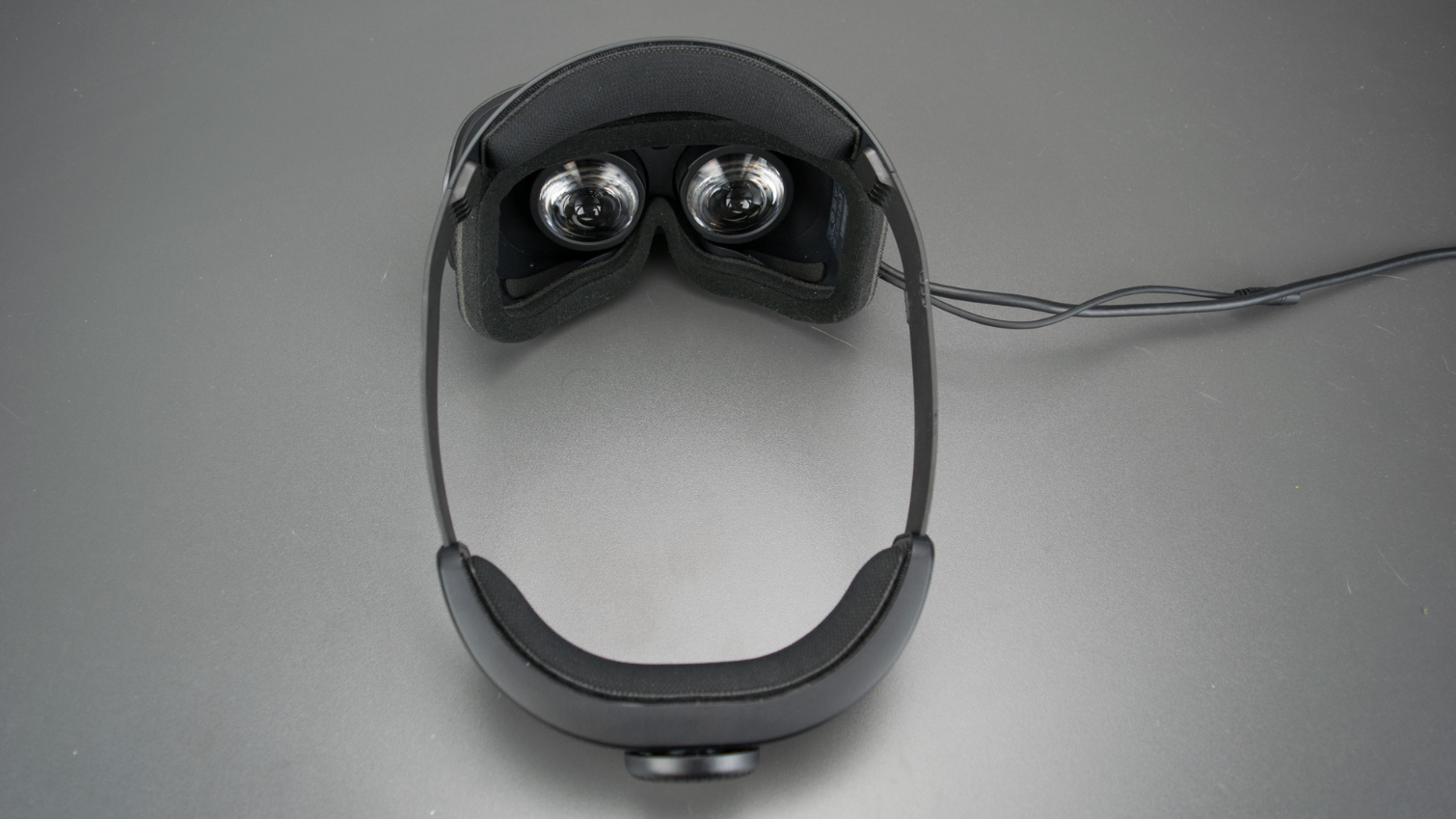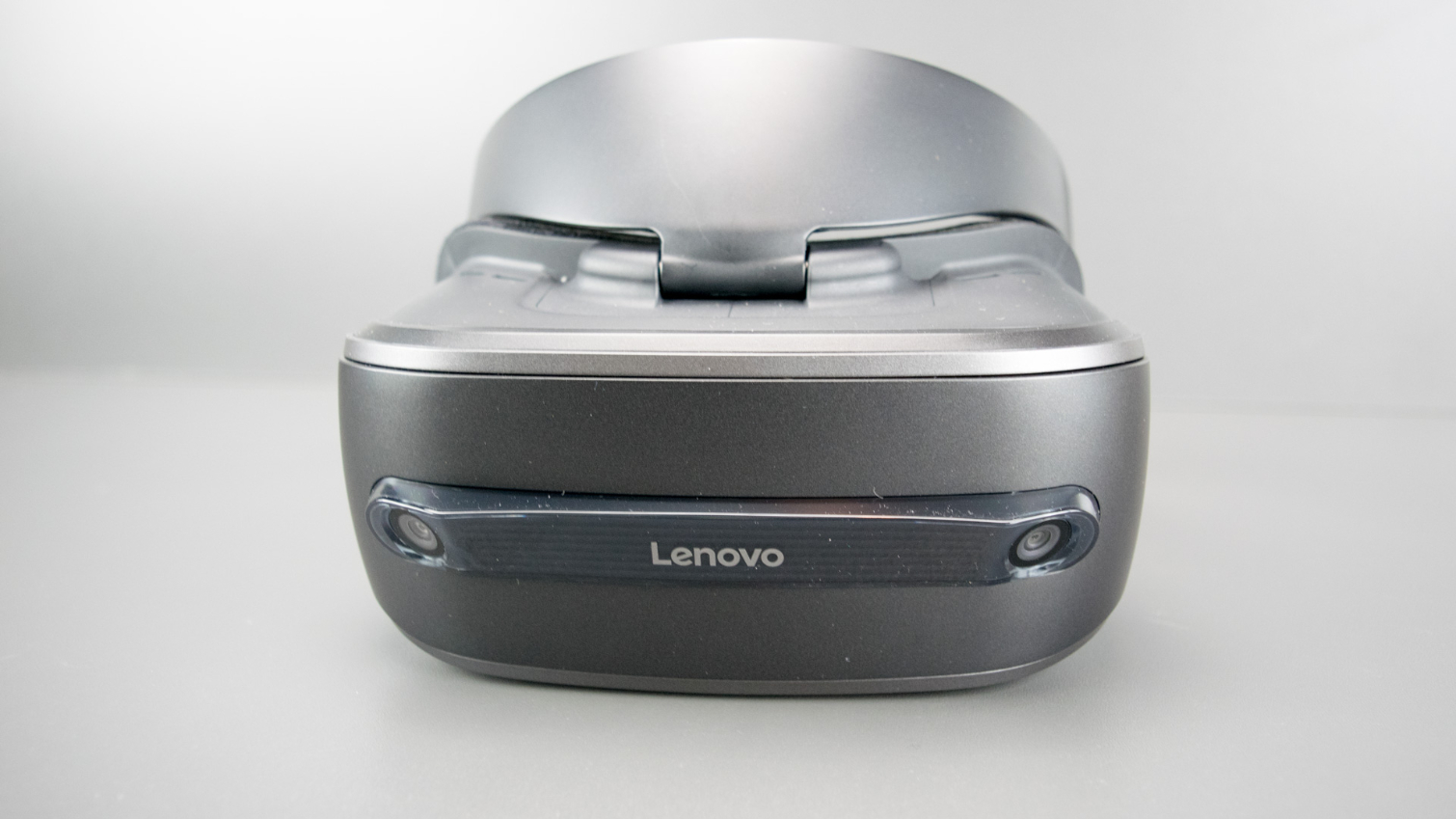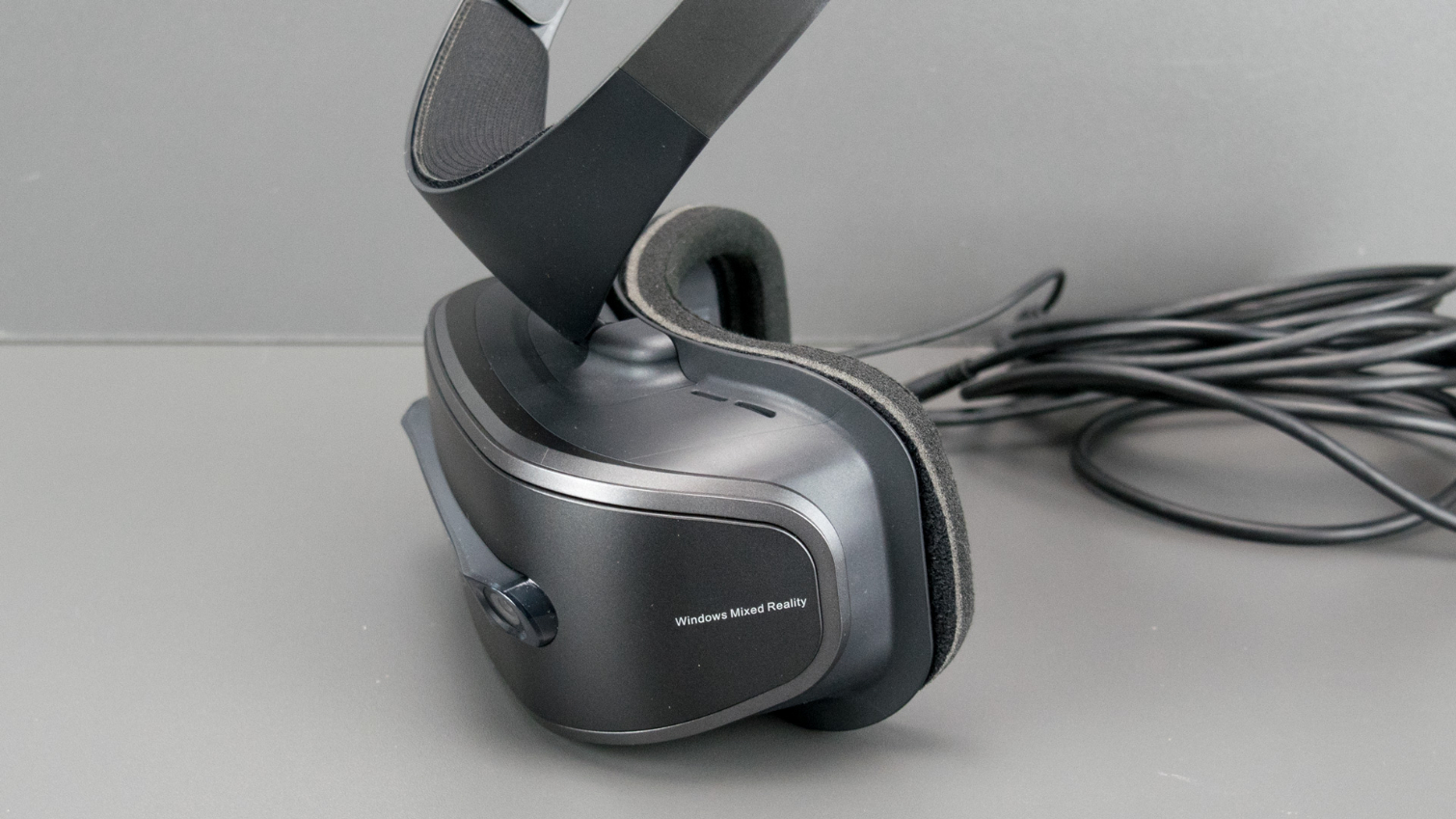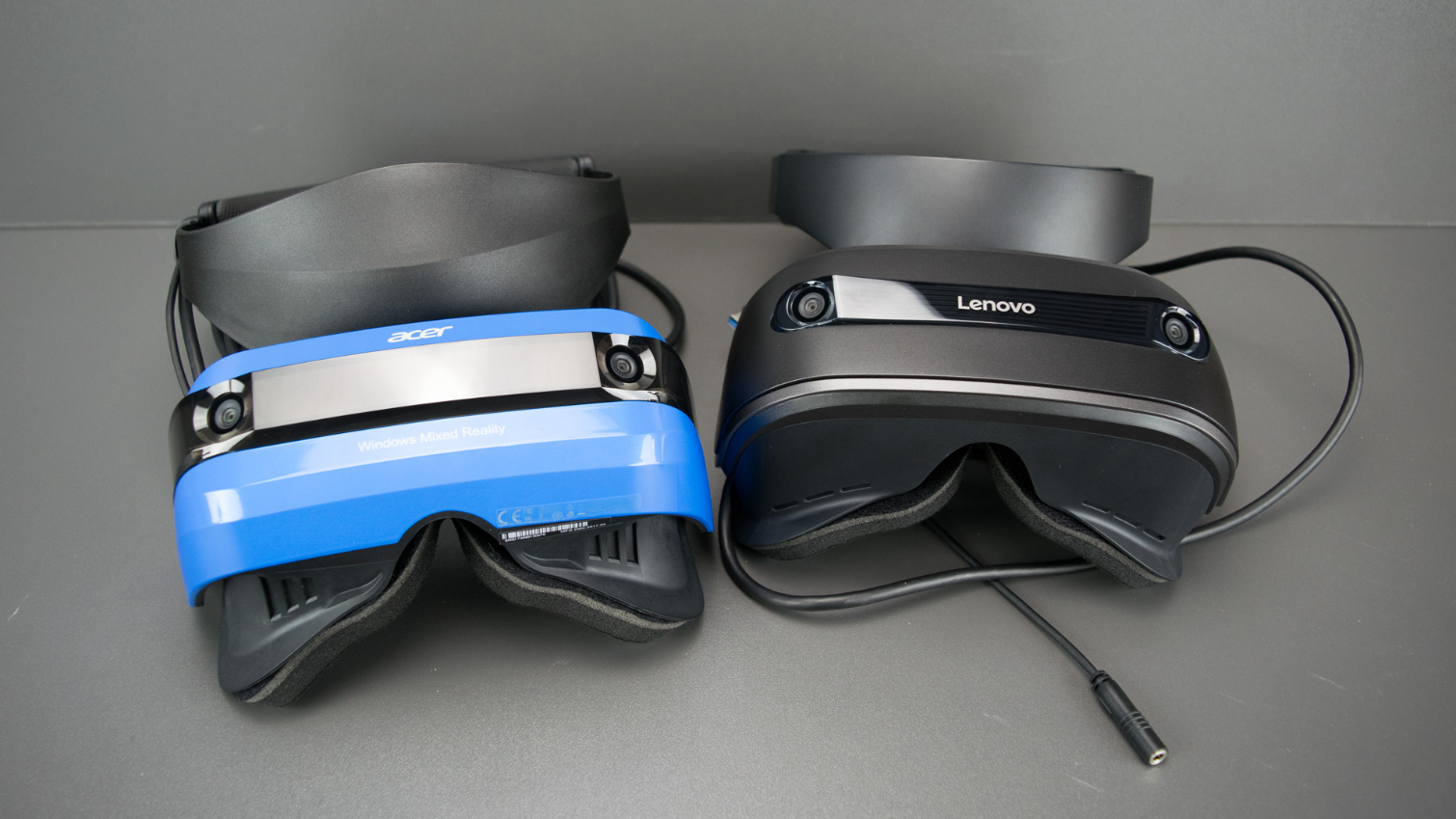Lenovo Explorer Windows Mixed Reality Headset Review: A Low-Cost VR On-Ramp
Why you can trust Tom's Hardware
The Lenovo Explorer Windows Mixed Reality Headset
The Lenovo Windows Mixed Reality Headset comes in a nice, secure package. The box opens from the top to reveal the headset and a box with the manual and cleaning cloth. Both motion controllers can be found held securely in form-fitting foam under the documentation. The package also includes four AA batteries for the controllers.
The Lenovo Explorer headset shares a lot in common with Acer’s HMD. Both companies stuck closely to Microsoft’s basic reference specifications with little deviation. The two headsets are so similar that we would be shocked if they aren’t assembled in the same factory.
Like all Windows MR headsets, the front of Lenovo’s Explorer headset features the tracking system from Microsoft’s HoloLens headset, which includes two infrared cameras and an infrared projector that beams IR light into the room for the cameras to detect. Both cameras face forward with a slight offset facing outward in opposing directions to provide ample tracking coverage in front and beside you. The cameras also tilt slightly downward to keep track of the floor for height calibration. The two cameras, combined with internal gyroscope, accelerometer, and magnetometer sensors, provide room-scale 6 degrees of freedom tracking in as large as an 11.5ft x 11.5ft (3.5m x 3.5m) space.
Like Acer’s headset, the Lenovo Explorer features dual 2” x 2.89” 1440 x 1440 LCDs, which can operate at 60Hz and 90Hz depending on the GPU powering the device. The Lenovo Explorer headset also shares the same 50mm round Fresnel lenses as Acer’s Windows MR HMD. And like Acer’s HMD, Lenovo’s headset features a fixed IPD of 63mm.
The high-resolution displays provide a clear, but not perfect, image. If you look closely, you can see faint outlines of the subpixels (the dreaded "screen-door" effect), but most people probably won’t notice. When your eyes line up with the sweet spot, the images are crisp and clear. However, the round Fresnel lenses distort the edges. When you glance your eyes to the border, you’ll see a warped, blurry image. The round lenses also appear to restrict the field of view more so than the custom lenses in the Rift and the Vive. The Lenovo headset makes you feel like you’re looking through a round porthole, which is exacerbated by the blurry extremities.
The Lenovo Explorer also features a halo-style head band like the Acer headset, which is to say it doesn’t include an overhead strap for added balance. Lenovo designed the headset to balance most of the weight on your forehead. The rear of the head strap sits low on our skull to help shift some of the weight to the back of your head. That is where you’ll find the tension-adjustment dial that enables you to tighten and loosen the strap. Like the Acer headset, Lenovo’s design doesn’t include a button to release the tension--you must turn the dial to loosen the strap. Lenovo’s tension mechanism feels marginally stronger and more resilient to wear and tear than Acer’s tension dial. However, when you loosen the dial, it makes a loud grinding noise that doesn’t instill confidence in long-term resilience.
The Lenovo Explorer headset also employs a hinge that enables you to tilt the headset up so you can see your surroundings. This feature is helpful when you need to reach for your mouse or keyboard, but like the head-strap tension dial, we worry about the longevity of the hinge system. When you tilt the headset upward, it locks into place, but we’re worried that the lock will wear down sooner than it should. Our evaluation unit is already showing signs of the visor sagging after a few dozen uses.
Get Tom's Hardware's best news and in-depth reviews, straight to your inbox.
The two headsets are a lot alike, but of course, they’re also quite different.
Acer chose a bright blue plastic for the outer shell of its headset. Lenovo’s Windows MR headset features a much more subdued color scheme. The bulk of the headset is made of black plastic, with dark-grey contrasting highlights to give it some character.
Like Acer’s headset, the Lenovo Windows MR headset is made of lightweight materials. Subjectively, the two devices feel nearly identical in weight. Objectively, the Lenovo headset is the lightest HMD that we’ve tested thus far. It weighs just 380 grams, which is 62 grams lighter than the Acer.
The size of the Lenovo headset likely plays a big role in its reduced weight. When we received the Acer headset, we were surprised by its tiny frame, and Lenovo’s headset is even smaller than Acer’s device. The visor of the Lenovo Explorer is 185.1 mm across, 94.8 mm tall, and 102.1 mm deep.


Because of its small size, Lenovo’s headset would fit people with smaller heads than the Acer headset. Not only is the visor more compact, but the headband of the Explorer headset is also the smallest that we’ve seen on a VR headset. Children shouldn’t spend extended periods of time in VR because it can have negative effects on eye development, but if you’re going to share VR with your kids, Lenovo’s headset is the one most likely to fit a child’s head. Conversely, the Lenovo Explorer may be too small for you if you have a larger-than-average noggin.
The Lenovo Explorer headset includes soft cushions on the forehead rest and the back of the head strap. The cushions feature a mesh texture, which is not resistant to moisture, and the face cushion is a softer material that wicks up moisture. Fortunately, these cushions are removable and washable, so you can clean them or replace them if necessary. All three cushions fasten to the headset with Velcro.
The Lenovo Explorer headset doesn’t include built-in headphones. Instead, it includes an audio lead that allows you to plug in a stereo headset with a microphone. The headset doesn’t include separate leads for the headphones and microphone. You must use a headset that includes a single triple-channel cable. You can also use wireless headphones. However, if you want to use the motion controllers with the HMD, you can’t use Bluetooth headphones. (The Windows MR platform doesn’t allow for it.)
The lead for the audio jack sticks out of the right side of the headset alongside the data cable for the device. The 4m-long data cable features a Y-split that includes USB 3.0 and HDMI connectors. The other end is hardwired into the headset, which means it would be difficult to replace it if you ever damage the cable.
The right side of the head strap features a clip that directs that data and audio cable to the rear of the headset. Unfortunately, Lenovo’s engineers didn’t think through the placement of this clip and the exit point of the cables very well. When we lifted the headset’s visor, the cable didn’t have enough slack, and the clip that guides the cable popped off the head strap and flew across the room. We were able to retrieve the clip and attach it to the headset, but it came off again the next time we flipped the visor. The data and audio cables should exit the visor closer to the hinge to reduce the amount of slack required to flip the headset.
The Controllers
We were disappointed to learn that, like the Acer headset, Lenovo’s Windows Mixed Reality Headset includes a pair of Microsoft’s reference motion controllers. There isn’t much else that we can say about the controllers that we haven’t covered in the Acer review. Lenovo’s wands are identical to Acer’s, right down to the plastic used to make them. The only discernable difference between them is the Lenovo logo on the handle of each controller in place of the Acer logo.
When we evaluated Acer’s controllers, we noted that the build quality left much to be desired, and our time with Lenovo’s controllers confirmed our fears. The thumbstick on the right controller started to show wear after just a few hours of use. It now clicks when we rotate it near the top of the ball, and there is resistance when we press the stick forward, as if the mechanism inside is now damaged. We suspected that these controllers would wear prematurely, but less than a week of use is worse than we feared. We hope our experience is an exception to the rule, but this is the second set of these controllers that let us down, which doesn’t bode well for Microsoft’s reference-controller design.
Microsoft’s reference-controller design gets the job done, but we wish Lenovo had taken the time to tweak the mold to make the controllers more ergonomic. We would have appreciated seeing an improvement in the plastic used for the mold to increase the controller’s rigidity, too.
Current page: The Lenovo Explorer Windows Mixed Reality Headset
Prev Page Introduction Next Page Evaluating Lenovo's HMDKevin Carbotte is a contributing writer for Tom's Hardware who primarily covers VR and AR hardware. He has been writing for us for more than four years.
-
justin.m.beauvais I agree with the idea that WMR is better as a portable VR solution. It is something I discovered after pairing my Acer WMR headset with my Helios 300. I can sit in my small office for work, watching movies, or playing games that I can remain seated, then move the laptop to the living room for room scale experiences. WMR excels at portability. Tracing out a play area, without worrying about lighthouses, and being able to turn on and off the boundary are great features. Having one of those fancy backpack PC's gives you as much play area as you have floor space. Just something to consider. I gladly trade a little tracking accuracy for a much more portable experience.Reply -
David_326 I own an Oculus Rift and a Lenovo Explorer Mixed Reality Headset. If cost is the Same go with the Rift (But add 3rd Sensor). I was able to get Lenovo WMR for $199 from Microsoft. that was just too good of a deal to pass up. If you want to be able to play Vive Games WMR Controllers work better than Oculus Rift. Also you don't sweat as much in the Lenovo as the Rift because it does not cover your face as much. Both have strong point.Reply -
David_326 Right now Lenovo Explore Mixed Reality Headset is $199 on Microsoft.Com. If you are considering getting in to VR. This is a great Starting point. it is Ranked the #2 Windows Mixed Reality Headset Right behind the Samsung WMR. But at this cost it is worth a try.Reply



